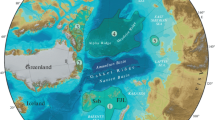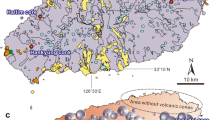Abstract
The Inyo Craters (North Inyo Crater and South Inyo Crater), and a third crater, Summit Crater, are the largest of more than a dozen 650- to 550-yr-B.p. phreatic craters that lie in a 1-km-square area at the south end of the Inyo Volcanic Chain, on the west side of the Long Valley Caldera in eastern California. The three craters are aligned within a 1-km-long northsouth system of fissures and normal faults, and coincide in age with aligned magmatic vents farther north in the Inyo Volcanic Chain, suggesting that they were all produced by intrusion of one or more dikes. To study the sequence and mechanisms of the eruptions, the deposits were mapped, sampled, and compared with subsurface stratigraphy obtained from the core of a slant hole drilled directly below the center of South Inyo Crater from the southwest. The deposits from the two Inyo Craters are fine-grained (median diameter less than 1 mm), are several meters thick at the crater walls, and cover at most a few km2 of ground surface. Stratigraphic relationships between the Inyo Craters and Summit Crater indicate that the eruptions proceeded from north to south, overlapped slightly in time, and produced indistinctly plane-parallel bedded, poorly sorted deposits, containing debris derived primarily from within 450 m of the surface. Debris from the deepest identifiable unit (whose top is at 450 m depth) is present at the very base of both Inyo Craters deposits, suggesting that the eruptive vents were open and tapping debris from at least that depth, probably along preexisting fractures, even at their inception. According to ballistic studies, the greatest velocity of ejected blocks was of the order of 100 m/s. All eruptions, particularly the least powerful, selectively removed debris from the finest-grained, most easily eroded subsurface units. Although juvenile fragments have been previously identified in these deposits, they are confined primarily to the grain-size fraction smaller than 0.25 mm dia. and probably did not constitute more than several percent of the deposit. It is therefore suggested that these juvenile fragments were not the main source of heat for the eruptions, and that the eruptions were caused either by: (1) heating of water by fragmented magma that was not ejected before the eruption shut off; (2) slow heating (over months to years) of groundwater under confined conditions without fragmentation of magma, followed by a second process (pressure buildup, seismic faulting, or intrusions) that breached the confinement; or (3) breach of a pre-existing confined geothermal aquifer.
Similar content being viewed by others
References
Bailey RA (1989) Geologic map of the Long Valley Caldera, Mono-Inyo Craters Volcanic Chain, and Vicinity, eastern California. US Geol Surv Misc Invest Map I-1933
Bailey RA, Dalrymple GB, Lanphere MA (1976) Volcanism, structure, and geochronology of Long Valley Caldera, Mono County, California. J Geophys Res 81: 725–744
Bailey RA, MacDonald RA Thomas JE (1983) The Inyo-Mono Craters: products of an actively differentiating rhyolite magma chamber, eastern California. Eos 64: 336
Bird RB, Stewart WE, Lightfoot EN (1960) Transport phenomena. John Wiley and Sons, New York, pp 1–780
Christiansen RL, Peterson DW (1981) Chronology of the 1980 eruptive activity. In: The 1980 eruptions of Mt St Helens, Washington. US Geol Surv Prof Paper 1250
Delaney PT (1982) Rapid intrusion of magma into wet rock: groundwater flow due to pore pressure increases. J Geophys Res 87: 7739–7756
Delaney PT (1987) Heat transfer during emplacement and cooling of mafic dykes. In: Geol Assoc Canada Spec Paper on Mafic Dyke Swarms, pp 31–46
Eichelberger JC, Vogel TA, Younker LW, Miller CD, Heiken GH, Wohletz KH (1988) Structure and stratigraphy beneath a young phreatic vent: South Inyo Crater, Long Valley Caldera, California. J Geophys Res 93: 13208–13220
Feuillard M, Allegre CJ, Brandeis G, Gaulon R, Le Mouel JL, Mercier JC, Pozzi JC, Semet MP (1983) The 1975–1977 crisis of La Soufriere de Guadeloupe (F.W.I): a still-born magmatic eruption. J Volcanol Geotherm Res 16: 317–334
Fink JH (1985) The geometry of silicic dikes beneath the Inyo domes, California. J Geophys Res 90 11127–11133
Finch RH (1943) Lava surgings in Halemaumau and the explosive eruptions in 1924. Volcano Lett 479: 1–4
Fisher RV (1968) Puu Hou littoral cones, Hawaii. Geol Rundsch 57: 837–864
Fisher RV, Schmincke H-U (1984) Pyroclastic rocks. Springer, Berlin Heidelberg New York, pp 1–472
Fudali RF, Melson WG (1972) Ejecta velocities, magma chamber pressure and kinetic energy associated with the 1968 eruption of Arenal volcano. Bull Volcanol 35: 383–401
Hedenquist JW, Henley RW (1985) Hydrothermal eruptions in the Waiotapu Geothermal System, New Zealand: their origin, associated breccias, and relation to precious metal mineralization. Econ Geol 80: 1640–1668
Gorshkov GS (1959) Gigantic eruption of the Bezymianny volcano. Bull Volcanol 2: 20
Heiken GH, Goff F, Stix J, Tamanyu S, Shafiqullah M, Garcia S, Hagan R (1986) Intracaldera volcanic activity, Toledo Caldera and Embayment, Jemez Mountains, New Mexico. J Geophys Res 91: 1799–1815
Huber NK, Rinehart CD (1965) Geologic map of the Devil's Postpile quadrangle, Sierra Nevada, California. US Geol Surv Map GQ-437
Le Guern F, Bernard A, Chevrier RM (1980) Soufriere of Guadeloupe 1976–77 eruption-mass and energy transfer and volcanic health hazards. Bull Volcanol 43–3: 577–593
Lloyd EF (1959) The hot springs and hydrothermal eruptions of Waiotapu. New Zealand J Geol Geophys 2: 141–176
Lorenz V (1970) Some aspects of the eruption mechanism of the Big Hole Maar, central Oregon. Bull Geol Soc Am 81: 1823–1830
Lorenz V (1973) On the formation of maars. Bull Volcanol 37: 183–204
Lorenz V (1986) On the growth of maars and diatremes and its relevance to the formation of tuffurings. Bull Volcanol 48: 265–274
Mastin LG, Pollard DD (1988) Surface deformation and shallow dike intrusion processes at Inyo Craters, Long Valley, CA. J Geophys Res 93: 13 221–13 235
Metz JM, Mahood GA (1985) Precursors to the Bishop Tuff eruption: Glass Mountain, Long Valley, California. J Geophys Res 90: 11 121–11 126
Miller CD (1985) Holocene eruptions at the Inyo Volcanic Chain, California — Implications for possible eruptions in Long Valley Caldera, Geology 13: 14–17
Minakami T (1942) On the distribution of volcanic ejecta (part I). The distributions of volcanic bombs ejected by the recent explosions of Asama. Bull Earthquake Res Inst Tokyo 20: 65–91
Moore JG, Nakamura K, Alcaraz A (1966) The 1965 eruption of Taal Volcano, Science 151: 955–960
Muffler LJP, White DE, Truesdell AH (1971) Hydrothermal explosion craters in Yellowstone National Park. Geol Soc Am Bull 82: 723–740
Nairn IA (1979) Rotomahana-Waimangu eruption, 1886: base surge and basalt magma. New Zealand J Geol Geophys 22: 363–378
Nairn IA, Wiradiradja S (1980) Lae quaternary hydrothermal explosion breccias at Kawerau Geothermal Field, New Zealand. Bull Volcanol 43: 1–13
Nairn IA, Wood CP, Hewson CAY (1979) Phreatic eruption of Ruapehu: April 1975. N Zealand J Geol Geophys 22: 155–173
Nakamura K (1964) Volcano-stratigraphic study of Oshima Volcano Izu. Bull Earthquake Res Inst, Tokyo 42: 649–728
Nelson CE, Giles DL (1985) Hydrothermal eruption mechanisms and hot spring gold deposits. Econ Geol 80: 1633–1639
Pollard DD, Fink JH, Delaney PT (1984) Igneous dikes at Long Valley, CA: emplacement mechanisms and associated geologic structures, US Geol Surv Open File Rep 84-939: 130–146
Prinz M (1970) Idaho rift system, Snake River Plain, Idaho. Bull Geol Soc Am 81: 941–948
Sampson DE, Cameron KL (1987) The geochemistry of the Inyo Volcanic Chain: Multiple magma systems in the Long Valley region, eastern California. J Geophys Res 92: 10 403–10 421
Self S, Sparks RSJ (1978) Characteristics of wide-spread pyroclastic deposits formed by the interaction of silicic magma and water. Bull Volcanol 41: 196–212
Self S, Kienle J, Huot JP (1980) Ukinrek maars, Alaska, II. Deposits and formation of the 1977 craters. J Volcanol Geotherm Res 7: 39–65
Shepherd JB, Sigurdsson H (1982) Mechanism of the 1979 explosive eruption of Soufriere volcano, St. Vincent. J Volcanol Geotherm Res 13: 119–130
Sheridan MF, Wohletz KH (1983) Hydrovolcanism: Basis considerations and review. J Volcanol Geotherm Res 17: 1–29
Sherwood AE (1967) Effect of air drag on particles ejected during explosive cratering. J Geophys Res 72: 1783–1791
Sieh K, Bursik M (1986) Most recent eruption of the Mono Craters, eastern central California. J Geophys Res 91: 12539–13571
Sorey ML (1985) Evolution and present state of the hydrothermal system in Long Valley Caldera. J Geophys Res 90: 11219–11228
Sorey ML, Suemnicht GA, Sturchio NC, Nordquist GA (1991) New evidence on the hydrothermal system in Long Valley Caldera, California from wells, fluid sampling, electrical geophysics, and age determinations of hot-spring deposits. J Volc Geotherm Res. in press
Steinberg GS (1977) On the determination of the energy and depth of volcanic explosions. Bull Volcanol 40: 116–120
Suemnicht GA (1987) Results of deep drilling in the western moat of Long Valley, California. Eos 68: 785–798
Suemnicht GA, Varga RJ (1988) Basement structure and implications for hydrothermal circulation patterns in the western moat of Long Valley Caldera, California. J Geophys Res 93: 13191–13207
Walker GPL (1971) Grain-size characteristics of pyroclastic deposits. J Geol 79: 696–714
White DE (1955) Violent mud-volcano eruptions of Lake City Hot Springs, northeastern California. Bull Geol Soc Am 66: 1109–1130
Whyte F (1968) Lower Carboniferous volcanic vents in the west of Scotland. Bull Volcanol 32: 253–268
Williams H, McBirney AR (1979) Volcanology. Freeman, San Francisco, pp 1–391
Wilson L, Head JW III (1981) Ascent and eruption of basaltic magma on the Earth and moon. J Geophys Res 86: 2971–3001
Wohletz KH (1986) Explosive magma-water interactions: thermodynamics, explosion mechanisms, and field studies. Bull Volcanol 48: 245–264
Wohletz KH, McQueen RG (1984) Experimental studies of hydromagmatic volcanism. In: Explosive volcanism: inception, evolution, and hazards. National Academy Press, Washington, pp 158–169
Wohletz KH, Sheridan MF (1983) Hydrovolcanic explosions II. Evolution of basaltic tuff rings and tuff cones. Am J Sci 283: 385–413
Wood S (1977) Distribution, correlation, and radiometric dating of late Holocene tephra, Mono and Inyo Craters, eastern California. Geol Soc Am Bull 88: 89–95
Yokoyama I (1956) Energetics in active volcanoes. 1st paper. (Activities of volcano Mihara, Ooshima Island during the period 1953–54). Tokyo Univ Bull Earthquake Res Inst 34: 190–195
Yokoyama I Energetics in active volcanoes. 2nd paper. Tokyo Univ Bull Earthquake Res Inst 35: 75–97
Author information
Authors and Affiliations
Rights and permissions
About this article
Cite this article
Mastin, L.G. The roles of magma and groundwater in the phreatic eurptions at Inyo Craters, Long Valley Caldera, California. Bull Volcanol 53, 579–596 (1991). https://doi.org/10.1007/BF00493687
Accepted:
Issue Date:
DOI: https://doi.org/10.1007/BF00493687




